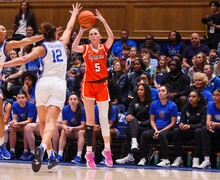Between 2 worlds: how Syracuse’s racist housing policies created a racial divide
Elizabeth Billman | Senior Staff Photographer
Lower-income neighborhoods in Syracuse have faced neglect as the surrounding university area attracts development.
The Daily Orange is a nonprofit newsroom that receives no funding from Syracuse University. Consider donating today to support our mission.
There are two worlds in Angel Gonzalez’s city.
In one, new buildings rise from freshly paved asphalt, a collection of luxury student apartment complexes attracted to the money that flows from the whiter, wealthier enclaves near Syracuse University’s campus. Here, the university’s student population stretches toward the city’s center, where the highest estimated concentration of 19 to 24-year-old Syracuse residents live.
In the other world, development in mostly family-occupied neighborhoods, such as Gonzalez’s in the city’s Westside, has stagnated due to limited economic and housing opportunities.
“I’ve been in and out of the Westside for 10 years, and that community hasn’t changed at all,” said Gonzalez, a sophomore history major at SU.
Some city residents who attend SU walk between those two worlds each time they travel from campus and to their home communities. As the whiter neighborhoods surrounding the university attract development and opportunity, other residential neighborhoods — especially those primarily occupied by the city’s Black, Latino and immigrant and refugee communities — have faced neglect.

Racist policies allowed the University Neighborhood to accumulate wealth at the expense of other neighborhoods. Madeline Foreman | Staff photographer
Several studies, including a report that CNY Fair Housing published Thursday, have attributed the differences in development across Syracuse to racist policies that allowed the University Neighborhood and adjacent whiter communities to accumulate wealth at the expense of other neighborhoods.
The disconnect is clear to Ruus Shirwa, a sophomore policy studies and economics major who has lived in Syracuse’s Northside and Eastside neighborhoods. Shirwa’s mother worked in SU Food Services for most of his life.
“I remember going with my father when we would drop (my mother) off, seeing all those nice areas and such and (being) very like, ‘Wow, this place is beautiful compared to where I used to live,’” Shirwa said.
The Southwest, Southside, Near Westside and portions of the Northside neighborhoods contain Syracuse’s and Onondaga County’s highest racially and ethnically concentrated areas of poverty. At least 40% of residents in these areas live below the poverty line, and at least 50% of the population are people of color, according to the CNY Fair Housing report.
Each of these neighborhoods experienced poverty rates ranging from 41-80%, according to estimates by the American Community Survey included in the CNY Fair Housing report. But whiter areas, such as the University Neighborhood, downtown Syracuse, Eastwood and Meadowbrook had much lower poverty rate estimates, between 0-20% and 21-40%.
More than 46% of households in the Southside struggle with housing cost burdens. But in Eastwood, Meadowbrook and the University Neighborhood, fewer residents face those same concerns, with several tracts in these areas having rates as low as 14-25%.
Overall, Onondaga County ranked as the second-worst community with racial income disparities in New York state, according to a 2018 survey from the Brookings Institution.
“There’s a big difference (in Syracuse neighborhoods) in the sense of socioeconomics,” said Zahabu Gentille Rukera, a senior communications and rhetorical studies major. “I feel like I’m in two different worlds, two different cities, when I’m on campus versus when I’m home.”
Policies that shaped their worlds
Racist government policies that have displaced roughly 1,200 families — including redlining and urban renewal projects such as the construction of the Interstate 81 viaduct — created visible discrepancies in access to quality housing that remain in Syracuse today, said Cooper Sirwatka, director of operations at CNY Fair Housing.
The federal government mapped American cities in the 1930s to rank neighborhoods’ eligibility for refinancing home loans. Neighborhoods with large Black populations, including downtown Syracuse and the portion of University Hill closest to I-81, were marked in red with lower grades, or “redlined.”
City planners drew the map boundaries citing racist fears of “infiltration” by residents of color, according to “A Place We Call Home: Gender, Race, and Justice in Syracuse,” a book by Kishi Ducre. Ducre is an associate dean for diversity, equity and inclusion in SU’s College of Arts and Sciences and an associate professor of African American studies.
The city planners also noted how close different neighborhoods were to areas or properties government authorities deemed more valuable, including SU’s campus.
Since residents of redlined areas didn’t have access to loans, their homes never increased in value after the maps were drawn, Sirwatka said. Ultimately, the city of Syracuse pushed the Black community into neighborhoods that never fully financially recovered from the policies and where the community largely remains today, Sirwatka said.
Other white-owned properties, including homes in the University Neighborhood, rose in value and continued to develop. SU’s land also grew in value, and the university, a predominantly white institution, expanded and continued its property development.

Elizabeth Billman | Senior Staff Photographer
Katie Marcy | Digital Design Director
During Syracuse’s East Urban Renewal Project in the 1950s, city officials cited lower redlining grades to authorize demolitions in Black neighborhoods. The city built parking lots, plazas and a downtown police station where families’ homes once stood, Ducre said.
Invasive developments continued as recently as the 2000s, with the construction of a sewage plant on Midland Avenue. The project forced the 45 families living in a nearby public housing complex to leave their homes by 2006.
The historical impact of these policies, combined with the renting practices that landlords in the university area have upheld, have reinforced the separation between wealthier residents and those with less access, Ducre said.
Landlords in the university area often exclusively rent to SU students at higher rates, Sirwatka said, because they know that students can usually afford higher rent prices than Syracuse locals.
The average cost of rent in the Northside, North Valley, Near Westside and Southwest ranged from $878 to $1,237 in Feb. 2020, according to Yardi Matrix, an American market intelligence company. The average cost in downtown Syracuse and the University Hill at that time were $1,440 and $1,635, respectively.
The resulting access barrier has left many city residents who struggle to find quality, accessible housing with some resentment for the university, Sirwatka said.

Nabeeha Anwar | Presentation Director
The city recently invested significant funds to improve housing code enforcement and into programs that raise housing quality, including a recent approval to build 50 affordable single-family homes. Despite these efforts, Syracuse has not made enough progress to reverse the developmental and socioeconomic divide between neighborhoods, the 2020 CNY Fair Housing report stated.
The 2020 report also found that, in the past six years, the city has made no progress on increasing access to public transportation for residents living in affordable housing developments, a problem that affects the 72.4% of city residents without vehicle access. The lack of access to transportation exacerbates other issues residents face, such as food insecurity.
Lingering pain
Places such as SU and the University Neighborhood, which have the funds to constantly redevelop properties, end up looking completely different than neighborhoods like Gonzalez’s, he said.
“(Black residents are) still feeling the pain of all those policies,” Sirwaka said. “And having SU right there… investing in their (own) neighborhood and watching that neighborhood grow is definitely a source of conflict.”
Those tensions exist on SU’s campus, too, Gonzalez said.
“A lot of the (non-local students) see a lot of the darker things here in the city too, or, I wouldn’t say darker things, but just like the crime rate and the poverty in the city,” Gonzalez said. “Whether you’re a student on campus or not, a lot of people see that just coming into the city.”
Shirwa sometimes hears SU students casually refer to Black and Hispanic students who are local to Syracuse as “townies,” which he finds frustrating.
Many Syracuse residents view the university as an overwhelming presence in the city, Rukera said. The money SU invests into its own development could be better spent on services for the city’s homeless and youth programs, Rukera and Shirwa said.
“Syracuse University makes a lot of money simply just from being in our area and bearing our name,” Shirwa said. “Aside from that, they have very little connection to the city.”
SU is committed to maintaining open partnerships with the broader Syracuse community, said Cydney Johnson, executive director for state and local government relations at SU’s Office of Government and Community Relations.
The university supports local organizations and allowed the city to use some of its downtown buildings as community spaces prior to the coronavirus pandemic, she said. SU also encourages students to engage with the city through organized activities, such as weekend fairs, she said.
The university also holds meetings with a group of 10 local neighborhood associations at least twice a year, Johnson said.
SU’s $47 million Connective Corridor system, which the university designed to “show off Syracuse,” offers free bus transportation for students from South and Main Campus to parts of downtown Syracuse. SU students who use the Connective Corridor system often don’t realize how much more there is to the city beyond what little they’ve seen of it, Gonzalez said.
The division between SU and the working-class communities that surround it is not unique to Syracuse, Ducre said.

Places such as SU and the University Neighborhood end up looking completely different than other neighborhoods. Corey Henry | Senior Staff Photographer
Ducre examined environmental justice from the perspective of Black mothers in the Southside in “A Place We Call Home.” Her conversations with residents reflected how disruptive racist housing and government policies can be to Black communities, Ducre said.
“Through both (legal) and de facto acts of segregation, vulnerable pockets are formed to house the undesired population,” she wrote. “The result is that the spaces and inhabitants are viewed by outsiders in either of two extremes: invisible or hypervisible.”
The I-81 overpass that divides the city to this day represents that psychological barrier, said William Simmons, director of the Syracuse Housing Authority, a public housing agency. SHA is now deeply invested in advocating for policies such as the proposed I-81 community grid, which Simmons hopes will bring the city together.
Still, Gonzalez, Rukera and Shirwa believe the relationship between SU and the surrounding underserved communities is not progressing fast enough. Even as some SU students and professors have advocated for surrounding neighborhoods, the institution has lagged behind, Ducre said.
“It’s been individual actors, and not the institution, (who) have responded with advocacy for these nearby neighborhoods,” she said.
The university needs a more comprehensive approach to give back to Syracuse neighborhoods, Shirwa said.
Looking out across the city from a hill on the Woodland Reservoir, Gonzalez pointed out the neighborhoods and parks that few SU students he knows, if any, have ever bothered to explore beyond campus.

Neighborhoods with large Black populations, including downtown Syracuse and the portion of University Hill closest to I-81, were marked in red with lower grades, or “redlined.”
Even from one of the highest points in the city, the differences in infrastructure and housing quality were easy for him to see. Ultimately, he and other local students want SU students who aren’t from the area to see their hometown through their eyes.
“My heart definitely stays in Syracuse,” said Shirwa, who hopes to eventually contribute to legislation to help improve conditions in the city. “We have our problems like every city, but we’re working on solutions unlike a lot of different places. And whether or not Syracuse University wants to help, we’re gonna find a way. I definitely have faith in that.”
Senior Staff Photographer Elizabeth Billman contributed reporting to this story.
Published on September 29, 2020 at 12:21 am
Contact Marnie: ammunozc@syr.edu






